THE
MOST TOXIC CATERPILLAR IN THE UNITED STATES!
This
page was born 11/23/2003. Rickubis designed it. (such as it
is.) Last update: 4/15/2022
Images
and contents on this page copyright ©2002-2022 Richard M. Dashnau
Go back to my home page, Welcome
to rickubis.com
Go
back to the RICKUBISCAM page.
Yes,
it is, according to some sources. This means toxic to the touch.
7/23/2014; 08/03/2014 A few weeks ago (7/27/14), I found an
"asp" caterpillar on one of the Water Oak trees on the Live Oak Trail at
the park. (the attached image is of that
caterpillar) At the time, I
thought this was a few months early, since my recollection was that we
would see these caterpillars around October. Then on 8/03/2014 I found
one (just
one) on an Oak Tree near the Observation Tower at 40 Acre
Lake. I also saw what appear to be many cocoons made by these insects.I
decided to look again for more detailed
information on this insect.
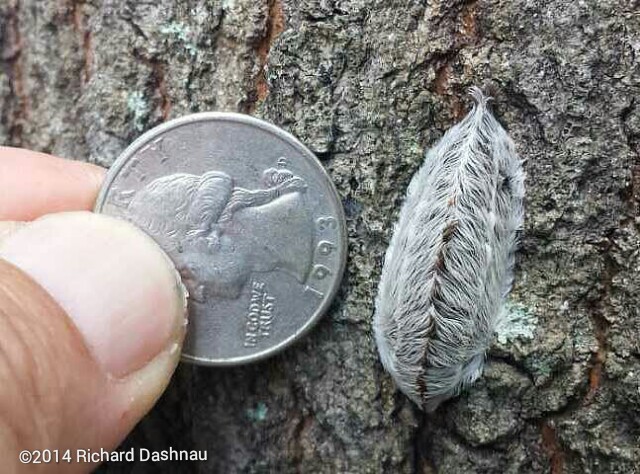
As
a reminder, the caterpillar called an "asp" in Texas is the larva of
the Southern Flannel Moth (Megalopyge Opercularis). There are a number
of
references to this insect online--but I found 3 very good ones this
time. The links I have here were good links today-08/11/2014 and
refer to pdf files that can be downloaded for free.
1)
An early study of the asp, from 1922 ( Foot NC. Pathology of the
dermatitis caused by Megalopyge opercularis, a Texan caterpillar.
Journal
of Experimental Medicine 1922; 35:737–753) gives a detailed description
of the physiology of the poison-delivery system, and
details observed effects of evenomation to human skin. From the detailed drawings and photos in this study, one can see the
general
shape of the venom-bearing hairs. They are hollow, with a bulbous base
which contains the venom sac. Some of these hairs have had the tip
broken off, but apparently they can
still penetrate human skin. The
study can be found at this link):http://europepmc.org/backend/ptpmcrender.fcgi?accid=PMC2128124&blobtype=pdf
2)A
later study (Envenomation by the asp caterpillar (Megalopyge
opercularis), by David Eagleman) gives more details on the evenomation
by the asp. Some interesting things from this
study include photos
showing the distinctive "grid" pattern, or rash, produced by the contact
of the caterpillar spines with human skin.There is also an effort to
define the geographical
distribution of these caterpillars. This is
generally southern states from Texas east up to Maryland, as well as
Arizona, Arkansas, North and South Carolina. Envenomations had been
reported for almost all 12 months, with February being the low spot. It
also showed 2 peaks of reported incidents-one in July, and one in
October. This study also describes some treatments.
The study can be
found here:
http://www.eaglemanlab.net/papers/Eagleman%20Asp%20Caterpillar%20Clinical%20Toxicology.pdf
3)Finally,
I found this information: Puss Caterpillar (Larva), Southern Flannel
Moth (Adult),Megalopyge opercularis (J. E. Smith 1797) (Insecta:
Lepidoptera:
Zygaenoidea: Megalopygidae, by Donald W. Hall)--published in 2012. This
article features some very good color photographs showing the life cycle
of the Southern Flannel
Moth. These include macro photos of the eggs,
and the various instars of the caterpillars as they grow to the final
familiar "wooly slug". ALL of the stages are venomous. There are also
references some of the habits of the caterpillar (for instance the larva
(caterpillar) eats its molted exterior as it grows--including the
poisonous spines. It also "propels its fecal pellets". The
asp has some
natural enemies,including some species of wasps and flies that use the
caterpillars to incubate their eggs. Consumption of their molts and
projection of the pellets may make
the caterpillars harder for these
potential parasites to track them. This study may be found here:
http://edis.ifas.ufl.edu/pdffiles/IN/IN97600.pdf
From what I've read on the links above, it appears that we've
just seen the end of the first seasonal appearance of the asps; and in a
couple more months, we may see them again.
09/05/2010 --I
noticed some odd-looking moths on some of our buildings (I saw some on
the 40Acre Lake bathrooms, and we had them on the door to the breezeway
on the VC.). I thought
they looked sort-of like honeybees wearing
fur coats. They appear to be Megalopyge Opercularis; aka the
Southern Flannel Moth. These are the adult form of one of our nastier
critters--the
asp caterpillar. So, for those who have been asked what
the adult asp looks like--now I can say. This might also mean that
we'll have another "bloom" of them this year. Last year, I only knew
of
them on a single tree by the Observation Platform in 40 Acre Lake.
The pictures below show the adult moths.
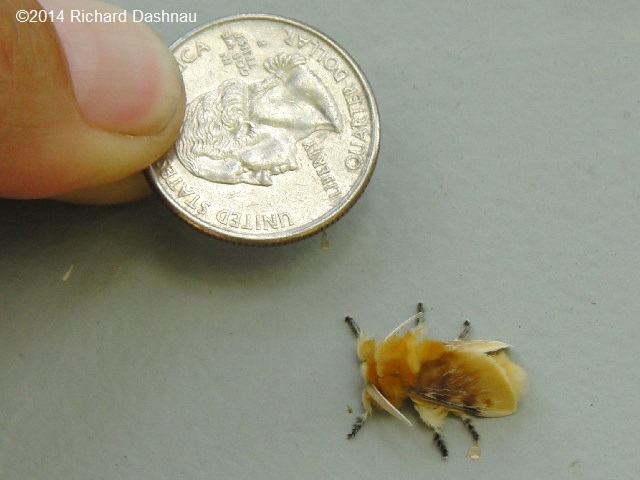 --
--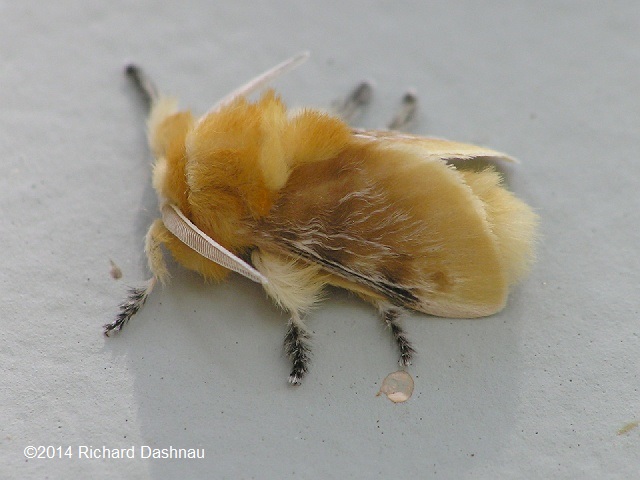 --
--
Southern Flannel Moth (adult "Asp Caterpillar")
Southern Flannel Moth (Megalopyge Opercularis)
10/21/2006
ASP ALERT--I was walking out of my apartment
today, and I turned to pull the door closed. I glanced up over the door
(I usually do this while looking for small creatures), and I
found a caterpillar
known here as an "Asp". This is also known as the "puss caterpillar" or
"wooly slug", and is known by the latin name of Megalopyge opercularis.
As I
looked around, I
quickly found 6 more Megalopyges in the area around my
door. Strangely enough, I didn't notice an around the apartments on either
side, but I didn't really want to wander around in front of
their windows.
Among the asps I found, I saw those with the familiar gray or ash coloring;
but I also found a few "blonde" ones, with a much lighter tan coloration.
With the opportunity at hand,
I shot some pictures and video clips of moving
asps. Some of them can be seen below.
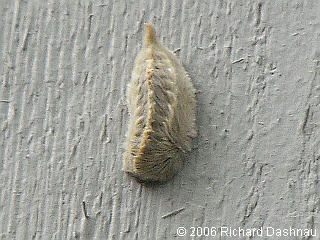 --
--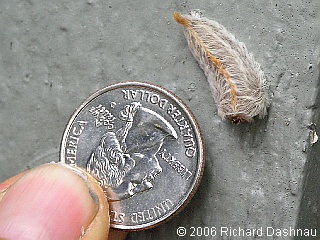 --
--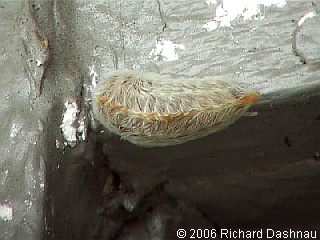
GREY A ONE
GREY A TWO
GREY A
THREE
GREY A CRAWLING 9.0MB
GREY A CLOSEUP 3.5MB
--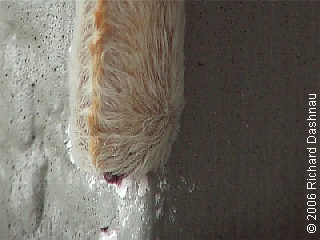 --
--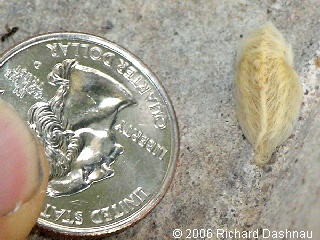 -
-
GREY A
FOUR
BLONDE A
The
second one I noticed was moving around quite a bit. In the images above
it is "GREY A". Image GREY A ONE is a top view. GREY A TWO shows a quarter
with it. GREY A THREE is a
frame from a video
clip showing it crawling on my doorframe, and GREY A FOUR is a single
frame from another video clip
showing it in closeup as it crawls through the camera view. The
image BLONDE
A above shows the lighter variant color with a quarter.
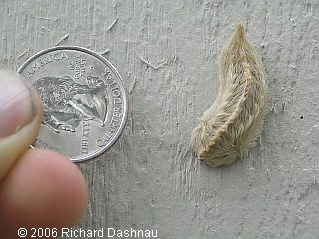 -
-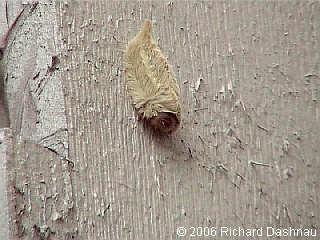 -
-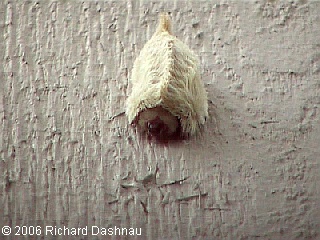 -
-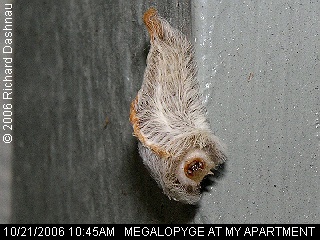
BLONDE B
ONE
BLONDE B
TWO
BLONDE B
THREE
YOU TALKIN' TO ME?
BLONDE B CRAWLING
4.5MB
BLONDE B FACE-ON 5.8MB
As I
watched the caterpillars, I noticed a large one coming down from my upper
floor. This was another blonde one, but nearly twice the size of the others.
It's not quite so apparent from the
pictures above, but that's because
of their ability to stretch. This one was noticeably larger than the others.
The image BLONDE B ONE above shows it with a quarter. BLONDE B TWO is a
frame from a video clip.
BLONDE B THREE is a frame from the last video
clip. For this one, I place the camera nearly under it as it moved
down. It was at least 3 feet above my head, and I
didn't want to be under
it if it fell. I climbed onto a ladder to get the picture with a quarter.
It's
been a few years since I did the story about these caterpillars, and I
hadn't seen many of them
since then. Perhaps all the rain we've been getting
has made conditions favorable for them. I've also seen some asps as Brazos
Bend State Park, but not as many in a small area as this.
That may have
changed since last week, though. In any case, be aware that they have "bloomed"
so watch what you lean on!
October
19, 2003Last
week's look at the "puss caterpillar" awakened my curiosity. So this
week, I decided to examine a Megalopyge opercularis a bit closer.
I bought some latex gloves,
and when I found another asp (it wasn't hard.
I found 3 asps in about 5 minutes. See FROM THE TOP, below, which was one
on the garage door.), I put it into one of my plastic vials, and
brought
it inside. After I set up my camera and a microscope, I put on a pair of
latex gloves; then another pair of latex gloves; then I put "finger
cots"--short latex covers--on top of the gloves.
When I finished, I had
about 5 layers of latex on my index finger and thumb. If I had gotten stung
through that, I would have been very impressed. See? I'm not
crazy!
Then,
I put the asp onto a plastic lid, and took a few short video clips.
Today's RICKUBISCAM shot is a frame from one clip, a fairly close view.
See the clip here (flv video
453 kb).
Here is another
clip (flv video 455kb) of a much closer view. One frame of this second
clip is shown as MUCH TOO CLOSE, below.
--------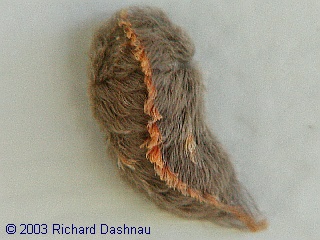 ---------
---------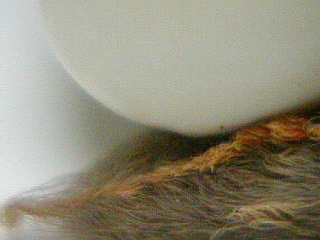 ---------------------
---------------------
FFROM
THE TOP
MUCH TOO CLOSE
I intended
to touch the Megalopyge, and then see if I could find any evidence of needles
or liquid (poison) on the glove. Although there might have been a few "hairs"
stuck to the latex (the
microscope was about 40x, and the macro shots are
about 30X), I couldn't really see any evidence of needles. If I can, perhaps
I'll try again. I wonder, though, if perhaps latex has enough
different
properties than skin to prevent penetration of the needles that I've read
about. After a while, I *did* start to feel discomfort and tingling
sensations in my finger. However, that was
from all the layers of gloves
cutting off my circulation (ha ha ha--false alarm!).
If you
look closely at the end of the "further away" clip, you'll see the asp
looking up at my finger (its little button
head appears); as if to say
"Are you STILL here? You should be screaming about now. ".
After
my examination and filming, I put the Megalopyge back into the vial, and
released it back
outside, on a tree *far* from any buildings or benches.
After all, asps don't *intentionally* hurt people. Actually, the times
people get stung are generally when they have crushed an asp
(accidently
or not). So, I let the poor youngster go. They're just trying to protect
themselves and live to old age...just like we are.
Actually
I kind of admire the fact that this relatively tiny creature
can almost
totally incapacitate an animal as large as a human just by standing there.
Talk about walking softly and carrying a big stick!
October
12, 2003It
looks like it isn't much of anything; just a tuft of fur, or a large dust
ball. But, they turn up where you least expect them, like on walls or rails
or benches or similar spots that
people like to lean on or lean over. And
then, when you lean on one, it feels like you ARE GOING TO DIE! Although
you might wish you did, you won't die, though. This is a caterpillar,
a larva
of the Flannel Moth (see WATCH OUT!, below). The latin name is
Megalopyge opercularis. The generally accepted common name is "puss caterpillar";
but here in Texas, they are generally
called "asps". A quick search
of the internet also turned up the very descriptive name "wooly slug".
According to one website, these are the most venomous caterpillars in the
U.S. They are
not too large, about 3/4 inch long, and not very striking
in appearance. In fact, with all that hair, they look almost "cuddly".
But, hidden within the hairs are removable hollow spines that contain
strong
venom. Contact with these spines immediately causes intense pain, rash,
blisters, and even nausea. I've read that one remedy is to use adhesive
tape to pull the spines out (which can
perhaps stop further envenomation).
The two pictures below show two other views of the "asp". The picture
FROM THE SIDE (below) shows the asp after I've prodded it a bit, and cause
it to
pull tight against the wood and arch its body--which elevated its
center hairs. The picture FLIPPED OVER (below) shows after I carefully
tipped it onto a leaf. This is more for curiosity's sake,
rather than identification;
since generally, if you see one in this position, you've already been stung,
and therefore have a pretty good idea you've encountered an asp.
-------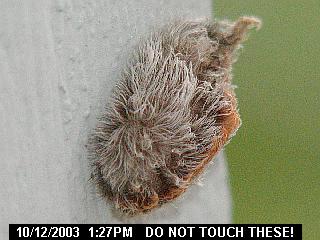 -
-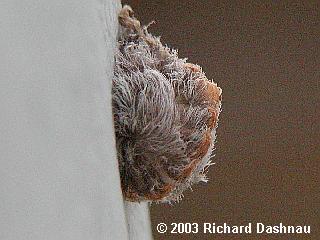 ---
---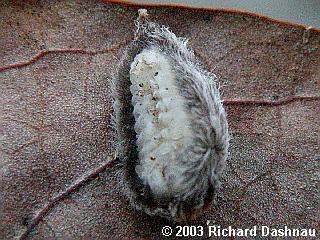 --
--
WATCH
OUT!
FROM THE SIDE
FLIPPED OVER
Here
is a short video clip (flv video
622kb) of the puss caterpillar flipping itself rightside up.
Notice the reddish hairs along the center.
I think
it's peculiar that these caterpillars are so nondescript in appearance.
Generally, extremely venomous animals are brightly colored, to call attention
the themselves. Being easily-
recognisable along with painful helps
insure that animals able to cause pain in defence are left alone by predators.
After a single encounter, most predators would learn to stay away. The
"asps", however, seem not to use this strategy. Instead, they seem to be
well-camouflaged, and not very obvious. A predator attempting to eat one
of these (and I can't imagine one that
would; they look like hairballs)
would immediately regret doing so. So I'd imagine that most envenomations
might be accidental. In that case, the stricken animal wouldn't know what
hit it,
and wouldn't learn what to avoid.
Yeah,
I know...ANOTHER stinging critter that lives down here. So what?
Texas is still a pretty cool state to live in.
Here
are some links to more information about these caterpillars. I usually
don't do this (link to others' pages), but this is important information.
These critters are MEAN! :Bugs
in the News Page, by Jerry Cates
Go back to my home page, Welcome
to rickubis.com
Go
back to the RICKUBISCAM page.
Go
back to the See the World
page.
















